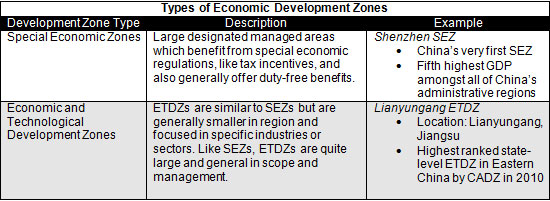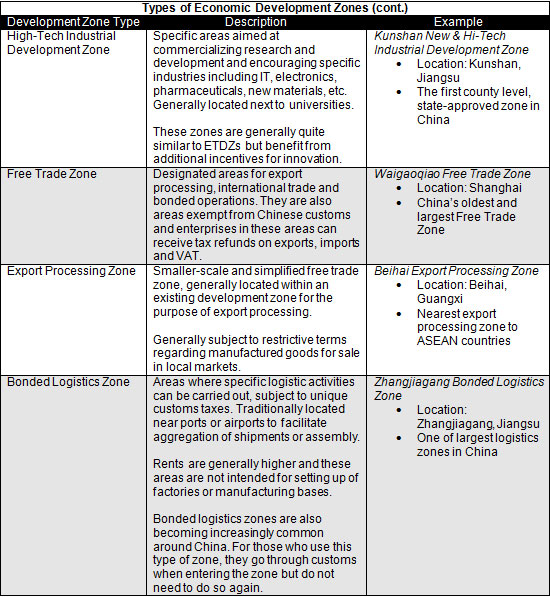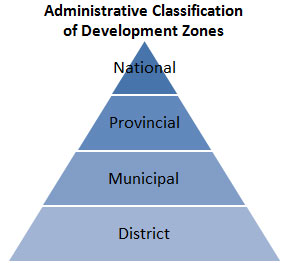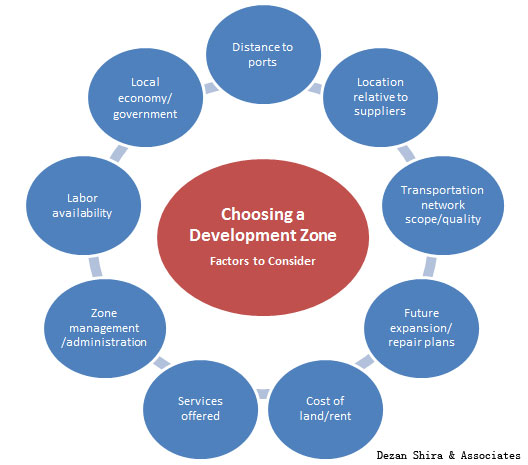Understanding Development Zones in China
Oct. 5 – China’s first development zones were established in the 1970s and few can deny the significance these economic areas have had in building the global powerhouse China is today. The origin of development zones in China can be traced back to 1978, when the country’s leaders were searching for a path to wealth and development to lift the country from economic and social disparity.
Development zones are not a Chinese creation, but China in particular has found tremendous success with this economic tool. Historically, the liberal business environment in these areas allowed foreign businesses to operate more comfortably in the Chinese business environment, sheltered from the bureaucracy and red tape that often characterizes the rest of the country. Development zones are successful in China primarily because of the central Chinese government’s strong support and the relative autonomy of zone managers.
The first development zones, hand-selected along the country’s southern coast in Shenzhen, Zhuhai, Shantou and Xiamen, acted as doorways through for the government to attract foreign direct investment and test whether the formerly centrally-planned economy could transition to a more liberal and capitalist model. These zones focused on aiding in manufacture for export to bolster the local economy without posing too significant a threat to state-owned enterprises.
The original drivers of the success of development zones are perhaps less relevant today than they were 30 years ago. Foreign investment in China pours into all regions of the country, not just development zones. As well, the 2008 Tax Reform took a hit at the tax incentives offered in development zones. Finally, foreign companies are increasingly interested in domestic sales, not solely focused on the exporting for which development zones were originally designed.
Regardless, the convenience of established infrastructure, reserved land and one-stop services available in development zones streamlines entry into China. For a manufacturer, an investment outside of a zone is comparatively more expensive and complicated, considering logistical and governmental issues.
Why invest in a development zone?
- Preferential policies
- Support and participation of government
- Autonomy
- Resource availability
- Hubs of technology, learning and innovation
Types of development zones
The largest and most comprehensive types of development zones are special economic zones (SEZs) and economic and technological development zones (ETDZs).

While SEZs and ETDZs are technically development zones, they are large in scope and focus. Investors will not likely find specific services or tailored benefits to meet their needs.
It is often more helpful to look at the following types of development zones.

Classifications of development zones
Development zones are often classified by industry (high-tech, heavy, light, agriculture or service) or by region (YRD, Bohai Ring, Central China) but the most defined of all classification systems is administrative level.
The central, provincial and regional governments play important roles in the establishment of development zones, with local governments often appointing state-owned enterprises to run these areas. The central government influences tax advantages as well as accreditation of zones.
In order to be certified as a national zone, the area needs to meet certain requirements – exact performance measures and related targets are not published, but parks are most likely assessed based on:
- Annual turnover (RMB100 billion+)
- Tax income
- Export volume
- FDI
 There are a number of benefits associated with choosing national vs. provincial, municipal or district certified parks. The higher ranked the park, the greater degree of autonomy the managers have in approving projects and tenants. For current or potential tenants of the park, greater autonomy generally means administrative tasks can be completed more quickly and inexpensively. Furthermore, higher-ranked zones also generally benefit from more support from the central government and more highly developed infrastructure. The major benefits associated with choosing a lower ranked park are typically related to lower land costs.
There are a number of benefits associated with choosing national vs. provincial, municipal or district certified parks. The higher ranked the park, the greater degree of autonomy the managers have in approving projects and tenants. For current or potential tenants of the park, greater autonomy generally means administrative tasks can be completed more quickly and inexpensively. Furthermore, higher-ranked zones also generally benefit from more support from the central government and more highly developed infrastructure. The major benefits associated with choosing a lower ranked park are typically related to lower land costs.
Keep in mind that larger and more established zones are not always better. Smaller companies operating in a national zone may find they do not receive all the same incentives larger corporations in the same area will receive. Similarly, resource availability and management capability vary greatly among zones and in fact, a district-level development zone may offer more incentives to smaller projects than a larger zone might.
Benefits of locating in development zones
There are a large number of benefits associated with development zones and these areas are attractive draws for investors looking for an easier way to take advantage of Chinese labor and other inputs.
Preferential policies compared to non-development zone areas
Development zones receive a number of regulatory benefits and privileges aimed at reducing the cost of investment and facilitating importing and exporting. Specifically, benefits include lowered land costs, tax awards and exemptions, facilitated customs clearance and ease of access to domestic markets.
In particular where taxes are concerned, some higher-ranked zones (i.e. national zones) have the ability to provide certain exemptions from national taxes.
Support and participation of government
The government’s support of development zones, at multiple levels, means foreign investors receive support in different terms and scopes. First, eager to attract foreign investors and consequentially boost the area’s employment and economic wealth, zone management will often be quick to respond to changes in needs related to regulatory or market changes. Local governments can also provide accounting, legal, marketing and consulting services to help investors.
The central government’s willingness to aid in the growth of these areas has manifested itself in the form of an improved policy framework and consequentially, clearer legal and regulatory standards.
Autonomy
Development zones are granted a high degree of autonomy, although many are government-sponsored projects which are run by state-owned enterprises. Many zones have the ability to unilaterally make decisions regarding investment projects and potential clients, which expedites regulatory and administrative tasks in the favor of investors.
Resource availability
Zones which specialize in certain industries/sectors will likely have access to specific resources and expertise which are favorable for investors.
Hubs of technology, learning and innovation
Development zones are often hubs for creativity and innovation, stemming from the provision of government incentives, competition between tenants and the presence of highly skilled labor.
Factors to consider when choosing a zone
Above all, the right type of development zone for an investor will depend on their specific business needs – such as industry, import/export plans, location of suppliers, labor/land/power requirements, and scale of operations. The factors which draw one investor to a particular development zone and another investor elsewhere are generally unique to the investor. So, the first step to development zone selection is a self-evaluation of your company’s priorities.

Once you’ve established these priorities, work with a consultancy firm to narrow down a list of zones. In any location of interest, seek out a list of companies that are already located in that zone. If you find the zone is occupied by companies with a similar background as yours, in terms of country or region of origin and what line of business they are in, it is valuable to reach out and gauge what their experience has been like.
Be mindful of the zone’s management and administrative practices. A well-run zone will be up to date on changes in regulations or in the marketplace which will affect you and will be able/willing to help you make the necessary adjustments.
Investigate the quality and scope of infrastructure networks; do not take statements about location lightly. High quality infrastructure will increase efficiency and lower transportation costs significantly. Keep a future-focused mindset and take plans for expansion or repair of these networks into account.
Finally, be conscious of the sustainability and future viability a zone. Regional governments are often extremely eager to set aside land for the future development of these areas. An excess supply of development zones in the 1990s and early 2000s left large areas of land idle and millions in invested infrastructure wasted. The central government eventually stepped in and forced the closure of 77.2 percent of existing zones, decreasing the number from 6,866 in 2003 to 1,568 in 2006. Another intervention by the central government is not impossible nor unlikely if growth of development zones blossom out of control again in the future.
When narrowing down a list of sites, recruit professional assistance. Typically, due diligence in this field requires assessment of the site itself, and the legal and tax implications of locating there.
Dezan Shira & Associates is a boutique professional services firm providing foreign direct investment business advisory, tax, accounting, payroll and due diligence services for multinational clients in China. In particular, the firm specializes in matching foreign enterprises with development zones. For relevant advice, please email info@dezshira.com, visit www.dezshira.com, or download the firm’s brochure here.
Related Reading
 Doing Business in China
Doing Business in China
Our 156-page definitive guide to the fastest growing economy in the world, providing a thorough and in-depth analysis of China, its history, key demographics and overviews of the major cities, provinces and autonomous regions highlighting business opportunities and infrastructure in place in each region. A comprehensive guide to investing in China is also included with information on FDI trends, business establishment procedures, economic zone information, and labor and tax considerations.
 The Yangtze River Delta: Business Guide to the Shanghai Region (Fourth Edition)
The Yangtze River Delta: Business Guide to the Shanghai Region (Fourth Edition)
This guide takes a practical, city-focused approach, walking you through the economy of important cities in the region with a level of specificity available through few other English sources. Its pages overview the region from a business standpoint, examine the economy of the region’s provinces and prominent cities in depth, and introduce the basics of establishing a business in the region.
MOFCOM Ranks China’s Top Development Zones
- Previous Article China Law Deskbook Legal Update – Oct. 2011
- Next Article The Legal Fundamentals of China M&As



























